Published
on 7
Jul 2004
|
All rights reserved.
|
|
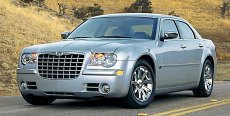 The
outgoing Chrysler LH-platform cars (Chrysler 300M, Concorde, LHS and
Dodge
Intrepid) were always remembered for their sharp, coupe-like look. They
were the best examples of Tom Gale’s "cab-forward" designs. However,
since
Daimler-Benz bought the company in 1998, everything was changed. Not
only
the American company started using Mercedes parts and engineering
know-how,
but its styling theme was also changed. You can see that from the trio
of new cars - Crossfire, Pacifica and now, 300. These cars have a
common
styling philosophy - conservative profile for easy engineering, radical
details to suit American taste. The "cab-forward" design has become
memory,
replaced by conventional long bonnet and near-vertical windscreen. This
wind-blocking shape is especially obvious in Chrysler 300. (BTW,
Chrysler
won’t tell us the aerodynamic drag figure.) Myself is not a fan of this
bulldog-like styling, but undeniably it has huge presence to observers. The
outgoing Chrysler LH-platform cars (Chrysler 300M, Concorde, LHS and
Dodge
Intrepid) were always remembered for their sharp, coupe-like look. They
were the best examples of Tom Gale’s "cab-forward" designs. However,
since
Daimler-Benz bought the company in 1998, everything was changed. Not
only
the American company started using Mercedes parts and engineering
know-how,
but its styling theme was also changed. You can see that from the trio
of new cars - Crossfire, Pacifica and now, 300. These cars have a
common
styling philosophy - conservative profile for easy engineering, radical
details to suit American taste. The "cab-forward" design has become
memory,
replaced by conventional long bonnet and near-vertical windscreen. This
wind-blocking shape is especially obvious in Chrysler 300. (BTW,
Chrysler
won’t tell us the aerodynamic drag figure.) Myself is not a fan of this
bulldog-like styling, but undeniably it has huge presence to observers.
The new
platform
is now called
LX. It gives birth to Chrysler 300 (the sedan), Dodge Magnum (the
wagon)
and probably a new age Dodge Charger in the future. The Chrysler 300
installed
with V8 engines are called 300C, leaving the name 300 for V6 versions.
The LX
is
very,
very large.
Measuring 5 meters in length and 3 meters-plus in wheelbase, it matches
any European limousines. Its direct competitor is actually a class or 2
smaller. Take a Volvo S80 for comparison, you will find the Chrysler
monster
is 177mm longer, 51mm wider and 49mm taller, while the wheelbase is a
massive
257mm longer ! this also implies its modern, non-American-like
proportion
with long wheelbase and rather short overhangs. By keeping it just 1 mm
short of the 5-meters mark, its chance for selling in European market
is
survived.
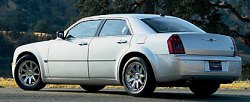 Now
one thing is interesting: while the outgoing LH platform was driven by
front wheels, the LX employs Mercedes-style rear-wheel drive. As we all
know the benefit of RWD to handling and driving pleasure, this must be
a good news. The question is: how can Chrysler afford the extra cost?
the
answer is easy: parts sharing with Mercedes-Benz and borrowing its
experience. Now
one thing is interesting: while the outgoing LH platform was driven by
front wheels, the LX employs Mercedes-style rear-wheel drive. As we all
know the benefit of RWD to handling and driving pleasure, this must be
a good news. The question is: how can Chrysler afford the extra cost?
the
answer is easy: parts sharing with Mercedes-Benz and borrowing its
experience.
The LX
cars
employ various
parts from Mercedes E-class, such as the 5-speed automatic gearbox, the
rear differential, ESP system, the double-wishbones front and 5-link
rear
suspensions. However, to reduce cost Chrysler converted suspension
parts
from aluminum to steel. American engines are also cheaper to build, so
Chrysler continues employing the LH’s 2.7-litre V6 (190hp) and
3.5-litre
V6 (250hp), plus a new generation "Hemi" 5.7-litre pushrod V8.
For a
car
weighing 1.7 ton,
even the 3.5 V6 is not going to provide performance matching a typical
3.0-litre European executive car. This is not helped by the use of
4-speed
automatic (the Mercedes 5-speed unit is reserved for V8). Don’t expect
ultra refinement for this somewhat outdated engine / transmission combo
either, as it is basically a bread-and-butter design.
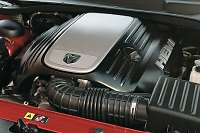 All
these reasons make the Hemi V8 more attractive. Yes, it is very heavy
due
to the cast-iron block, it is a pushrodder, but it is an all-new
design,
employing twin-spark plugs and cylinder deactivation technology like
Mercedes’
V8 and V12. When the car doesn’t need full power, it will automatically
deactivate 4 of the 8 cylinders by shutting valves and disabling fuel
injection
and ignition. This save a bit fuel. When the car needs full power, Hemi
can deliver 340 horses at 5000rpm and 390 pound-foot of torque at
4000rpm,
enough to push the car to 60mph in less than 6 seconds. All
these reasons make the Hemi V8 more attractive. Yes, it is very heavy
due
to the cast-iron block, it is a pushrodder, but it is an all-new
design,
employing twin-spark plugs and cylinder deactivation technology like
Mercedes’
V8 and V12. When the car doesn’t need full power, it will automatically
deactivate 4 of the 8 cylinders by shutting valves and disabling fuel
injection
and ignition. This save a bit fuel. When the car needs full power, Hemi
can deliver 340 horses at 5000rpm and 390 pound-foot of torque at
4000rpm,
enough to push the car to 60mph in less than 6 seconds.
Despite
of such
performance,
Chrysler 300C is not actually a performance sedan like BMW 545i. It is
too big and heavy for that. In fact, Chrysler installed it with 60%
aspect
ratio tires, showing it has no intention to market it against
performance
sedans. We had better see it as a regular sedan with extra low-end
grunt
as a bonus. Another bonus of the V8 is its smoothness and great sound.
With
rear-wheel-drive and
better weight distribution (54:46 for the V8), the LX platform of
course
handles better than its predecessor. Body control, grip, steering and
ride
are reasonably good by European standard. Not up to the level of BMW,
Mercedes
and Jaguar of course, but it won’t feel shame against other European
executive
sedans such as Volvo and Audi. The tuning is very European-like, with
heavy
steering in particular. In terms of refinement, the Chrysler 300 has
improved
a lot from its the LH. Its chassis feels solid and wind noise
insulation
is effective. Only sharp bump absorption let it down.
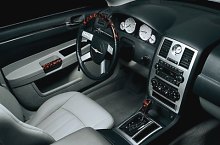 Inside,
the 300 offers unrivalled space in the class - actually more than most
people need. 5 big guys can sit comfortably as in any luxurious
limousines
3 times the price. Unluckily, the dashboard design is workman-like
rather
than out of thinking-man’s taste, lack of any elegant feel. The plastic
materials are lifted from LH, but not up to international level yet,
obviously
a class lower than Pacifica. Inside,
the 300 offers unrivalled space in the class - actually more than most
people need. 5 big guys can sit comfortably as in any luxurious
limousines
3 times the price. Unluckily, the dashboard design is workman-like
rather
than out of thinking-man’s taste, lack of any elegant feel. The plastic
materials are lifted from LH, but not up to international level yet,
obviously
a class lower than Pacifica.
Chrysler
wants to
sell 240,000
units of 300 and Dodge Magnum each year. This seems feasible for the
North
American market. However, for most other countries these big, thirsty
monsters
can only be sold as niches. To me, buying a smaller, handsomer, more
efficient
and more elegantly engineered executive cars seems a better bet. |
Verdict:    |
Published
on 27
Apr 2005
|
All rights reserved.
|
|
Chrysler 300C SRT-8
|
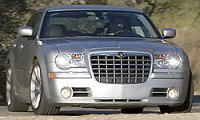 From
the exterior, you can hardly tell this is SRT-8. Performance Chryslers
used to look wild, usually wilder than the performance they deliver.
But today Chrysler is controlled by German who prefer huge performance
in low profile – look at those 500-horsepower Mercedes and you know.
That's why the “Street, Road and Track with 8-cylinder” version of
Chrysler 300C differs from the regular car by just bigger wheels, wider
tires, a slightly deeper chin spoiler, a pair of additional air intakes
at the front bumper and a tiny tail spoiler. From
the exterior, you can hardly tell this is SRT-8. Performance Chryslers
used to look wild, usually wilder than the performance they deliver.
But today Chrysler is controlled by German who prefer huge performance
in low profile – look at those 500-horsepower Mercedes and you know.
That's why the “Street, Road and Track with 8-cylinder” version of
Chrysler 300C differs from the regular car by just bigger wheels, wider
tires, a slightly deeper chin spoiler, a pair of additional air intakes
at the front bumper and a tiny tail spoiler.
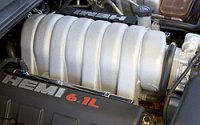 That's
only the look, of course. When you open the bonnet, A-Ha, this is where
it make the big difference. Instead of the ugly plastic engine cover,
you will see 8 long metal intake manifolds resting in the V-valley,
either side is a cam cover with the word “HEMI” and a red “6.1L”. This
is the hottest version of the HEMI V8. Chrysler bored it out to 6059
cc, increased compression ratio from 9.6 to 10.3:1, employed larger
valves, higher flow intake manifolds, ports and exhaust, lighter hollow
valve stems, stronger forged steel crankshaft, stronger connecting
rods... as a result, the 6.1 HEMI is more eager to rev. It pumps out
425 horsepower at 6200 rpm, far more than the 5.7 HEMI's 340 hp at 5700
rpm. This translate to a multi-valve-engine-like specific output of 70
hp per litre, even higher than Chevrolet Corvette's LS2 engine ! That's
only the look, of course. When you open the bonnet, A-Ha, this is where
it make the big difference. Instead of the ugly plastic engine cover,
you will see 8 long metal intake manifolds resting in the V-valley,
either side is a cam cover with the word “HEMI” and a red “6.1L”. This
is the hottest version of the HEMI V8. Chrysler bored it out to 6059
cc, increased compression ratio from 9.6 to 10.3:1, employed larger
valves, higher flow intake manifolds, ports and exhaust, lighter hollow
valve stems, stronger forged steel crankshaft, stronger connecting
rods... as a result, the 6.1 HEMI is more eager to rev. It pumps out
425 horsepower at 6200 rpm, far more than the 5.7 HEMI's 340 hp at 5700
rpm. This translate to a multi-valve-engine-like specific output of 70
hp per litre, even higher than Chevrolet Corvette's LS2 engine !
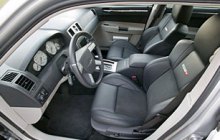 Predictably,
the big V8 is immensely torquey. As much as 420 lbft is available at
4800 rpm. It pushes the 1910 kg monster from standstill to 60 mph in
merely 4.9 seconds and to 100 mph in an Evo-beating 11.5 seconds.
Remember, it does this with a 5-speed automatic gearbox ! Predictably,
the big V8 is immensely torquey. As much as 420 lbft is available at
4800 rpm. It pushes the 1910 kg monster from standstill to 60 mph in
merely 4.9 seconds and to 100 mph in an Evo-beating 11.5 seconds.
Remember, it does this with a 5-speed automatic gearbox !
Not only performance, the SRT-8 is also strong at handling.
Modifications to the chassis include lower ride height (by half an
inch), stiffer springs and thicker anti-roll bars, jumbo-size (20-inch)
alloy wheels, very wide tires (245/45ZR front and 255/40ZR rear) and
very powerful Brembo brakes (360mm front, 350mm rear, with 4-piston
calipers). What it lacks are those excessive electronic trickeries
which often ruin driving fun.
 SRT-8 is
an honest driving machine. It corners with immense grip and rock-steady
body control. The brakes are powerful and fade-free. Steering is
weighty and confidence inspiring. It responds keenly to driver input.
Unlike the regular, softer riding 300C, it feels far smaller than it
is, giving the driver enough confidence to tackle the twisties.
Inevitably, the ride is firm but never punishing, and noticeably
smoother than Cadillac CTS-V. Chrysler has done a great job ! SRT-8 is
an honest driving machine. It corners with immense grip and rock-steady
body control. The brakes are powerful and fade-free. Steering is
weighty and confidence inspiring. It responds keenly to driver input.
Unlike the regular, softer riding 300C, it feels far smaller than it
is, giving the driver enough confidence to tackle the twisties.
Inevitably, the ride is firm but never punishing, and noticeably
smoother than Cadillac CTS-V. Chrysler has done a great job !
However, the most brilliant is that they do this without costing your
fortune. In the USA, the SRT-8 is sold at just US$40,000, considerably
cheaper than BMW M3 (US$47,000 and leanly equipped), Cadillac CTS-V
(US$50,000), BMW M5 (US$80,000) and Mercedes E55 AMG (US$80,000). That
actually put it at a lower price segment. In this way, the big Chrysler
can easily storm the field by its strong performance and
driver-delighted handling. The only reservation is fuel consumption,
especially now the 6.1 engine has lost the cylinder cutoff technology
in favour of lighter valvetrain. Otherwise we can hardly think of any
reason not to love the SRT-8. Chrysler has finally created a winner. |
Verdict:      |
Published
on 1
Feb 2011
|
All rights reserved.
|
|
Chrysler 300 facelift (2011)
|
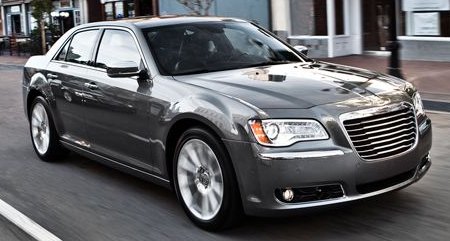
Having went through the refreshed Dodge Charger, Challenger
and Chrysler 200, we are coming to the last puzzle of Chrysler's 2011
product update campaign – the flagship Chrysler 300. Frankly, the old
300 had few things wrong. Its brash, flamboyant design is still iconic
today. Its underpinning was engineered in the DaimlerChrysler era with
strong inputs from Germany, so it sported a rear-drive chassis,
multi-link suspensions and Mercedes gearbox for decent dynamics. Its
home-grown HEMI V8 even guaranteed great performance and sound.
Nevertheless, after soldiering for nearly 7 years, it badly needed a
refresh. So what has Chrysler done to it ?
To make it appear new to consumers, Chrysler has reworked its exterior
styling quite extensively. Gone is the old car's bold and muscular
styling theme, replaced with a much softer, more civilized style. A
rounder radiator grille might be somewhat out of place with the rest of
the body, but the sleeker headlamps with high-tech-feeling LED elements
do make it classier. A faster angle windscreen contributes to a sleeker
profile and fuels the debate that whether this is a facelift or a new
generation. Slimmer A-pillars improve visibility and deliver a sense of
user friendliness for the first time. The new 300 looks more in harmony
with human, society and environment, a world away from the old car.
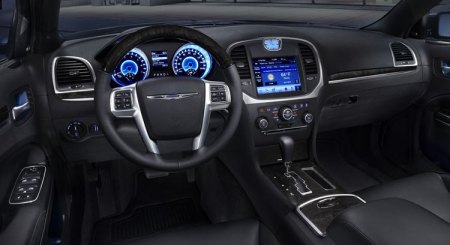
Even bigger change is the interior. Say goodbye to the old car's blocky
design and shinny hard plastics. They have been replaced with a modern
layout made of soft-touch plastics and good-looking faux alloys. A more
sophisticated ambience is realized by cyber-blue backlit gauges and
large LCD touch-screen. Touch the buttons and switchgears and they give
the same tactile feel as European executive cars. Better quality
leather trim is used on steering wheel, door panels, seats and arm
rest. On the move, you will notice the much improved noise insulation,
which makes the cabin quiet on highway cruising. The combination of
soft suspensions and long wheelbase delivers a supple ride, too.
The chassis has received relatively less attention, but it still gets
retuned suspensions for better handling. Grip and body control are
slightly improved as a result. On the other hand, new electrohydraulic
steering seems to be more precise, although it is still short of feel.
Anyway, the updated 300 is easier to place on narrow roads than
imagined, especially with the lighter V6 at its nose. For a car so
large, it is surprisingly agile.
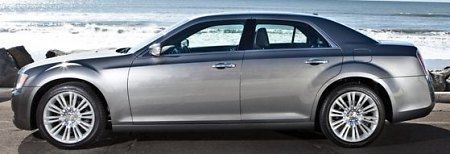
Talking about V6, the new 3.6-liter Pentastar with all-alloy
construction and dual-VVT is undoubtedly a considerable improvement
from the old 3.5-liter unit, thanks to a 42 horsepower boost and a
positive attitude to rev. However, it is not particularly torque low
down. To get the large car passing slower traffic you will need to
keep the V6 boiling at the upper end of its rev range. The aging
Mercedes 5-speed auto tranny doesn't help in this respect, too.
Fortunately, by the end of this year a world-class transmission will
arrive – guess what ? ZF 8-speed automatic !
Compare with the Pentastar V6, the carried over 5.7-liter HEMI V8 is
less sensible for environment and your wallet. However, with mountains
of bottom-end torque, hence an effortless acceleration from rest to 60
mph in 5.5 seconds, we can understand why it has plenty of fans in the
America. I suspect, given cheaper fuel price and wider road space,
European motorists could take this car over their turbo diesel Mondeo
or Passat. (note: the new 300 will be offered in Europe, but it will be
rebadged as Lancia Thema and come with diesel engine instead.)
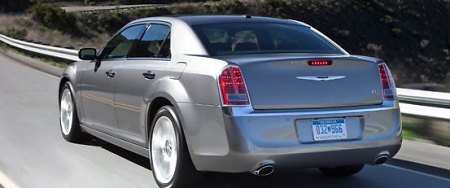
Overall, the updated 300 is the best
effort among all the refreshed models recently launced by Chrysler.
While its softer new look may not be as iconic as the old one, its much
upgraded interior quality, driving refinement and base V6 engine
complement the fine chassis and V8 power of the original car. Bettering
Buick LaCrosse and Ford Taurus by far, it is the best American big car
you can buy. |
Verdict:     |
Published
on 23
Nov 2011
|
All rights reserved.
|
|
Chrysler 300 SRT8 6.4
|
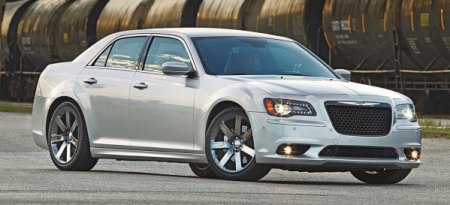
The old Chrysler 300
SRT-8
was one of the few highlights of the American motor industry. It was
probably the only Detroit product – well, although it was actually
built in Canada – that earned five stars and topped its segment in the
14 years history of AutoZine. Its success could be attributed to a few
important factors, namely, Detroit muscles, a Mercedes-derived chassis,
American-size accommodation and affordable price. No one else came
close to its bland of these merits. European sports sedans are
unquestionably more refined and elegant, but they either ask for absurd
money or fail to accommodate five full-size adults. Moreover, I
actually love the in-your-face styling of the old 300, SRT-8 or not. It
made all those M-cars or S-cars understated in comparison.
The new 300 SRT8 is no longer as outstanding as before, because the
makeover introduced earlier this year has softened its appearance a
lot. A mesh grille is supposed to lift its image above the regular
300C, but the visual effect is unconvincing. Same story for the 7-spoke
alloy wheels, which is nowhere as stylish as the ones on sister car
Dodge Charger SRT8 (see below). Just as before, the SRT8 differs just
slightly from lesser models, so my dislike of the latter's looks extend
to the hot version as well.
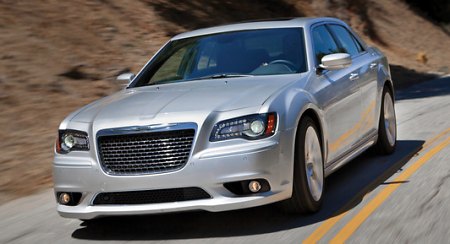
The biggest news is the new 6.4-liter Hemi V8. It comes intact from
Challenger SRT8. Not only features a slightly larger displacement, it
has added variable valve timing to its sole camshaft, variable length
intake manifolds and cylinder deactivation technology – the
latter is
shared with the 5.7-liter version on 300C. As a result, EPA highway
consumption is improved from 19 mpg to 23 mpg. Horsepower is lifted
from
425 to 470, while torque is improved by 50 lbft to 470 lbft. Again, it
offers more "bang for the buck" than anything else in its price segment.
While it is not quite M5-quick, the Chrysler muscle car can sprint from
rest to 60 mph in less than 5 seconds and get to the ton (100 mph) in
just over 10 seconds. The latter is nearly 2 seconds quicker than its
closest rivals Audi S4 and BMW 335i M Sport. Its top speed is now a
remarkable 175 mph, although that is less relevant to the drivers in
America. The rumble of its pushrod V8 is also a distinctive advantage
over its six-cylinder rivals in our ears. No matter from the noise or
g-force, its performance seems to be in another league.
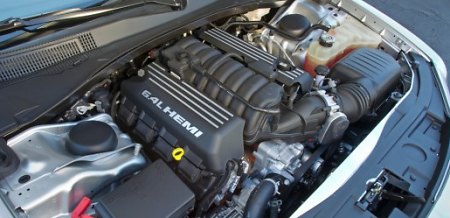
In fact, the bottom-end torque is so strong that each downshift sends a
violent shock to the occupants, ruining refinement. This has to blame
the carried over 5-speed automatic which has yet to learn how to handle
the new-found torque from the 6.4-liter engine. It cries for the
regular car's ZF 8-speed box. In principle there is no technical
difficulty to fit that transmission, as many of its applications on BMW
and Audi are torquer still. We don't understand why Chrysler failed to
equip it from the outset. Undoubtedly, the old transmission is the
Achilles' heel of this car.
Compare to the old car, changes to the chassis are quite subtle. It
still employs good old hydraulic steering and large Brembo brakes like
the old car. The only new item is Bilstein ADS electronic
adaptive dampers. Like the Skyhook suspensions on Maserati, it offers
continuous adjustment to damping stiffness according to speed, g-force
and road conditions, and on the top of that the driver can select
either Comfort or Sport mode to further tailor the handling to his
liking. In reality, the Sport mode is so harsh that only glass-smooth
highways are suitable. Anyway, the new SRT8 displays a slightly more
refined ride and less understeer than before. It still understeers into
corner, but you can easily induce power slide through the throttle
pedal. As long as the road is wide enough, the SRT8 is going to
entertain like an M3 !
However, that entertaining character may not be a surprise to owners of
the old car. What the new car has really taken a quantum leap is
quality and refinement. Better sound insulation surrounding the cabin
reduces noises a lot. Soft-touch plastics, better fit and finish,
high-tech instruments and touch-screen infotainment system make the
cabin far more desirable. If not the poor transmission integration, we
could have given the SRT8 another 5-star rating. |
Verdict:     |
Published
on 26
Nov 2011
|
All rights reserved.
|
|
Lancia Thema
|
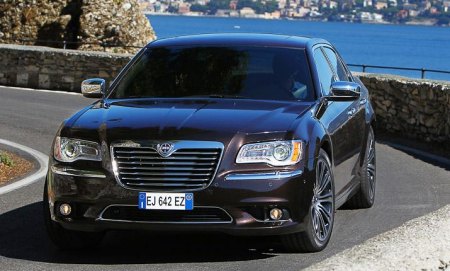
Lancia has long been
a
headache to Fiat boss Sergio Marchionne. The falling brand sold only
100,000 to 120,000 cars annually in the past decade. That is not enough
to sustain its product development. While its small cars (Ypsilon, Musa
and Delta) can be easily derived from Fiat platforms, its large car is
more problematic. Marchionne failed to make a business case for the
replacement of Thesis. It was supposed to share platform with the
future large Alfa Romeo (successor to 166), but given the dismal sales
record of Thesis, Kappa and 166, any rational person can reach the
conclusion that the combined volume of both Lancia and Alfa would not
be enough to justify the development of a new platform. As a result,
the replacement programs of both cars have been delayed. Following the
acquisition of Chrysler group, Marchionne came up with a new idea for
its brands to help each other – in mainland Europe, the Chrysler large
cars will be rebadged as Lancia for sale. In UK, where Lancia has been
absence for nearly two decades, the Lancia small cars will be rebadged
as Chrysler. This could boost the presence of both brands without
costly development.
So the new Lancia Thema is actually a rebadged Chrysler 300. It even
spent no time to restyle the car (except a new grille with the Lancia
badge) as its twin sister won't be available in the same market anyway.
Moreover, I suspect no restyle can hide its American origin, thanks to
that muscle-car-meet-a-brick shape. Same story for the interior, where
a Lancia-badged steering wheel is the only difference. When you are
short of money, you have no room to talk about brand identity.
Engine lineup is different from the Chrysler. The 3.6 Pentastar V6 is
still there, although rated at 286 hp instead of 292 hp. Hemi V8 is
abandoned as no European will buy it anyway. Taking its space is a
3.0-liter turbo diesel V6 supplied by VM Motori. This engine has been
serving European Chrysler and Jeep for some time. It produces either
190hp or 239hp. The high power version is accompanied with 406 lbft of
torque, so real-world performance is not as poor as its power-to-weight
ratio might suggest. In fact, the diesel motor is pretty good, being
refined and delicious to ears. Only a slight turbo lag separates it
from the best diesel engines offered by German maker.
That said, Lancia Thema is going to face a hard time against the likes
of Audi A6, BMW 5-series, Mercedes E-class and Jaguar XF in Europe, not
only because it is not as well built and well rounded, but it is not
cheap enough to justify its badge and its American origin.
|
Verdict:    |
Published
on 23
Dec 2014
|
All rights reserved.
|
|
Chrysler 300 facelift (2015)
|
|
It’s nearly 4 years
since Chrysler 300 got facelifted last time, and its basic design is
now over 10 years old. Somehow, Fiat Chrysler wants to keep it
soldiering for a few more years, so it has given the car yet another
facelift. The 2015 model has lost the high-performance SRT8 due to low
demand (sigh!), but the mass production V6 and V8 Hemi models have been
refreshed inside and outside. Most obvious is a larger mesh front
grille, which corrects the fault of the last facelift, if not
sufficient to bring back the presence of the 2004 car – scroll up and
make you own judgment. Inside, the instrument pod now features blue-lit
electro-luminescent gauges and a 7-inch color LCD between them. On the
center console, the touchscreen is upgraded to 8.4-inch. The gear
selector is converted to a rotary knob like Jaguar, and it is
supplemented with paddles at the steering column. The new steering
wheel (from Chrysler 200) is more stylish and nicer to hold in your
hands. Build quality and tech features have been consistently improved
over the years. Now the slogan “Imported from Detroit” is no longer
deceiving.
On the mechanical side, modifications are subtle but nonetheless
effective. The 3.6-liter V6 on sportier model 300S gets cold-air intake
duct and lower backpressure exhaust, boosting output by 8 hp to 300 hp.
The 5.7-liter pushrod V8 is kept unchanged, but it now pairs with ZF
8-speed automatic instead of the old Mercedes-derived 5-speeder. Its
fastest shift time in manual mode is reduced from 400 to 250 ms, which
helps the car feeling more responsive in acceleration, and the extra
ratios help improving fuel economy a bit. Besides, the 300 has its
steering switched from electro-hydraulic to rack-mounted electric motor
assistance. It doesn’t downgrade steering feel because the old rack had
little anyway, but it improves on precision and weighting. Also new is
a Sport mode which alters the steering, gearshift and throttle
response. It makes the 300 feels less bulky than before. The 300S model
with stiffer suspensions, 20-inch wheels and fat rubbers especially
highlight the new found agility, while the 300C remains a comfortable
tourer. The big Chrysler sedan is no BMW, not possible for something
this large and heavy, but its rear-drive chassis still holds a decisive
edge over Japanese or Korean front-drive near-luxury cars resting at
the same price level. Moreover, it looks and feels unique. This is not
going to be changed no matter how many more facelifts are to be
introduced.
|
   
|
Published on 6
Jul 2023
|
All rights reserved.
|
|
300C 6.4 (2023)
|
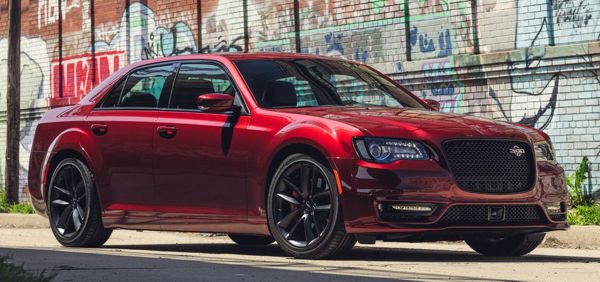
|
|
Long-lasting
Chrysler 300 bows out with a bang.
|
|
Started back in 2004, this
is the oldest standing page in AutoZine’s new car archives. Amazingly,
the Chrysler 300 is still in production today, although it did get a
couple of
mid-life makeovers in 2011 and 2015. Now it is finally coming to the
last chapter with a batch of 2200 cars, all of them are the ultimate
edition 300C, powered by a 6.4-liter V8.
You might remember the 6.4-liter HEMI powered the 300 SRT8 from 2011 to
2014. Since then the most powerful engine available to the 300 was the
5.7-liter HEMI. It is nice to see Chrysler refuses to play the usual
lazy game for the final edition but reintroduces the largest and most
powerful naturally aspirated V8 into the car. In the latest form, as
used
in Dodge Charger and Challenger 392, the 6.4-liter pushrod V8 produces
485 horsepower and 475 pound-foot of torque, propelling the 2-ton sedan
from rest to 60 mph in 4.3 seconds and 100 mph under 10. Many modern
sedans are quicker, especially those equipped with turbocharged engines
and all-wheel drive, but the big Chrysler still relies on good old
rear-drive and naturally aspirated power, the latter provides instant
yet linear thrust along with deafening noise under full throttle,
something missed out by today’s sports sedans. It is a great way to say
goodbye to the big American sedan.
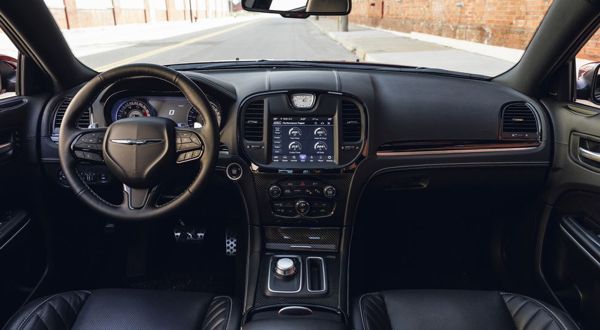
|
|
The
300C is not exactly a sports sedan, but a very powerful and
sonorous-sounding high-speed cruiser.
|
|
The 300C comes standard with limited slip differential, adaptive
dampers and Brembo brakes, which makes its $55,000 price a bargain.
However, it is not going to resurrect the SRT nameplate, so the rest of
the car is pretty normal. It is shod with Goodyear all-season tires
whose grip level fails to match its power. In addition to a less than
sophisticated traction and stability control, it is easy to spin the
rear wheels with too much throttle, much like old-school American
muscle cars. Therefore, the 300C is not exactly a sports sedan, but a
very powerful and sonorous-sounding high-speed cruiser.
Naturally, its interior looks dated, especially the smallish
touchscreen and its infotainment system, as well as the analogue clock
in the middle. The plastics feel a bit low rent these days. On the plus
side, there are plenty of good old physical switchgears, while cabin
space is aplenty. Outside, the 300 still looks proud and very American.
It deserves to live another generation, if not forever. What a pity the
market has changed a lot during the past 2 decades. As American public
no longer buys conventional large sedans, the 300 has to follow the
footsteps of so many American nameplates to rest into history.
|
Verdict:    |
|